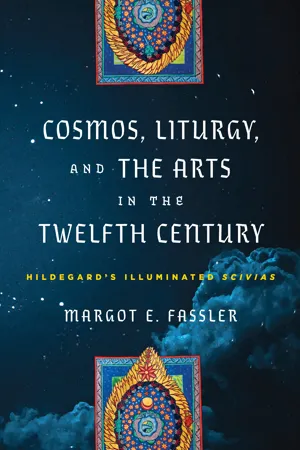
Cosmos, Liturgy, and the Arts in the Twelfth Century
Hildegard's Illuminated "Scivias"
- 400 pages
- English
- ePUB (mobile friendly)
- Available on iOS & Android
Cosmos, Liturgy, and the Arts in the Twelfth Century
Hildegard's Illuminated "Scivias"
About this book
In Cosmos, Liturgy, and the Arts in the Twelfth Century, Margot E. Fassler takes readers into the rich, complex world of Hildegard of Bingen's Scivias (meaning "Know the ways") to explore how medieval thinkers understood and imagined the universe. Hildegard, renowned for her contributions to theology, music, literature, and art, developed unique methods for integrating these forms of thought and expression into a complete vision of the cosmos and of the human journey. Scivias was Hildegard's first major theological work and the only one of her writings that was both illuminated and copied by scribes from her monastery during her lifetime. It contains not just religious visions and theological commentary, but also a shortened version of Hildegard's play Ordo virtutum ("Play of the virtues"), plus the texts of fourteen musical compositions.These elements of Scivias, Fassler contends, form a coherent whole demonstrating how Hildegard used theology and the liturgical arts to lead and to teach the nuns of her community. Hildegard's visual and sonic images unfold slowly and deliberately, opening up varied paths of knowing. Hildegard and her nuns adapted forms of singing that they believed to be crucial to the reform of the Church in their day and central to the ongoing turning of the heavens and to the nature of time itself. Hildegard's vision of the universe is a "Cosmic Egg, " as described in Scivias, filled with strife and striving, and at its center unfolds the epic drama of every human soul, embodied through sound and singing. Though Hildegard's view of the cosmos is far removed from modern understanding, Fassler's analysis reveals how this dynamic cosmological framework from the Middle Ages resonates with contemporary thinking in surprising ways, and underscores the vitality of the arts as embodied modes of theological expression and knowledge.
Frequently asked questions
- Essential is ideal for learners and professionals who enjoy exploring a wide range of subjects. Access the Essential Library with 800,000+ trusted titles and best-sellers across business, personal growth, and the humanities. Includes unlimited reading time and Standard Read Aloud voice.
- Complete: Perfect for advanced learners and researchers needing full, unrestricted access. Unlock 1.4M+ books across hundreds of subjects, including academic and specialized titles. The Complete Plan also includes advanced features like Premium Read Aloud and Research Assistant.
Please note we cannot support devices running on iOS 13 and Android 7 or earlier. Learn more about using the app.
Information
Table of contents
- Cover
- Series Page
- Title Page
- Copyright
- Dedication
- Contents
- List of Illustrations
- List of Tables
- List of Abbreviations
- Note on Conventions
- Introduction
- Chapter 1. The Cosmological Background
- Chapter 2. Scivias on the Rupertsberg
- Chapter 3. Cosmology and the Liturgy: Hildegard and the One Enthroned
- Chapter 4. Hildegard and the Hexameron
- Chapter 5. The Cosmic Egg and the Liturgy
- Chapter 6. The Edifice of Salvation and Its Virtues
- Chapter 7. Fall and Recovery in the Ordo virtutum
- Chapter 8. Endings and Time Beyond Time
- Color plates
- Appendix 1. Locations of Paintings, Flourished Initials, Headings, and Quire Signatures in Wiesbaden 1
- Appendix 2. Scribes Responsible for Texts and Headings in MS W, Wiesbaden 1, Illuminated Scivias, from Black-and-White Photos
- Appendix 3. Texts for the Office of All Saints, with Commentary
- Appendix 4. Smaller Dramatic/Musical Units as Found in the Ordo virtutum
- Notes
- Bibliography
- General Index
- Index of Chants and Chant Texts from the Liturgy, Symphonia and the Ordo virtutum
- Index of Scripture
- Index of Manuscripts
- Acknowledgments